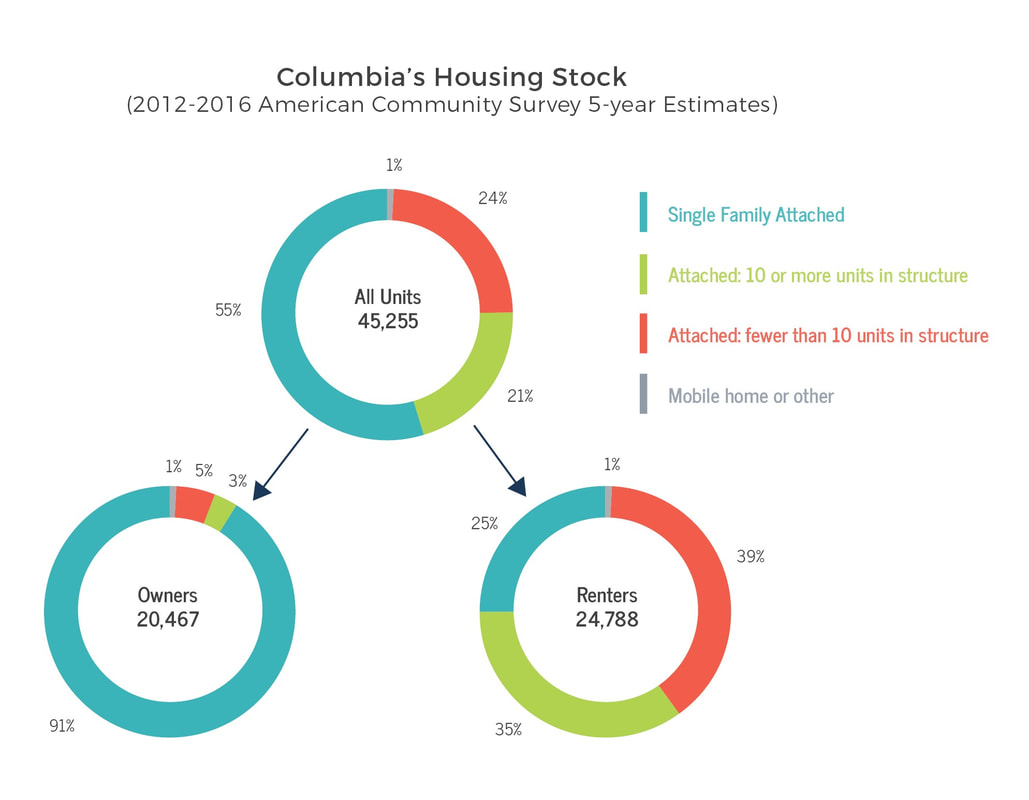Guiding Principles
We believe in...
- Creating walkable and vibrant neighborhoods connected to destinations where residents can learn, shop, work, and play.
- Enhancement and stabilization of underserved neighborhoods using inclusive efforts to expand opportunity, choice, and safety.
- Managing change in existing neighborhoods to support the protection of historical and cultural characteristics and reduce impacts on established neighborhood character.
- Advancing development of adequate and affordable housing for our families, workers, seniors, and disadvantaged community members.
- Ensuring the Columbia community has access to a mix of housing and neighborhood choices throughout the City.
HOUSING ELEMENT DOCUMENTS
The housing element is one of the nine elements of Columbia Compass: Envision 2036.
The housing element is one of the nine elements of Columbia Compass: Envision 2036.
|
HOUSING CHAPTER (PDF)
The housing chapter includes a discussion of the above guiding principles; a brief synopsis of the existing conditions; and a number of recommendations for the next ten years, as well as supporting case studies. |
|
APPENDIX D: HOUSING (PDF)
A detailed housing market assessment and policy analysis was developed during the research phase of the plan, and an synopsis of these reports is also included within the housing chapter under existing conditions. |
|
COLUMBIA'S HOUSING STOCK
Columbia is home to about 132,500 people living in 45,300 housing units. Just over half of those are renters (55%; a slight increase from 53% in 2010). Overall, about 55% of homes in Columbia are single family detached structures. Currently, the vast majority (91%) of owners live in single family detached units. Compared to the MSA overall, Columbia's homes are older and have fewer bedrooms. (2012-2016 American Community Survey 5-Year estimates) |
(2012-2016 American Community Survey 5-Year estimates)
Did you know...The median rent in Columbia rose from $536 per month in 2000 to $742 in 2010. By 2016, median rent had increased to $853 per month. (2012-2016 American Community Survey 5-Year estimates) |
COLUMBIA'S MARKET TRENDS
Trends over time indicate substantial increases in rental prices in Columbia, consistent with the regional market overall. Between 1999 and 2016 rents rose faster than incomes - reducing affordability in the rental market. As a result, renters may find it harder to save for a downpayment and prepare for homeownership, even though sale prices generally rose at a manageable pace relative to incomes. The median price of homes on the for-sale market in Columbia has risen 32% since the recessionary low in 2012, making homebuying difficult for many potential buyers while increasing equity for those who already owned a home. Wages also play an important role in housing affordability. Among the five largest industries that employ Columbia residents (which account for 55% of all resident workers) only one industry has average wages high enough to afford the City's median rent of $853/month and median sale price of $115,000. (2012-2016 American Community Survey 5-Year estimates; MLS data; and BBC Research & Consulting) |
|
FUTURE HOUSING NEEDS
If the current trends of rising rents and home prices continue, an increasing proportion of households may be priced out of the market for both rental and for-sale properties. A close examination of these trends, coupled with community preferences gathered by residents throughout the public engagement process, will be important considerations for future policy recommendations. |





